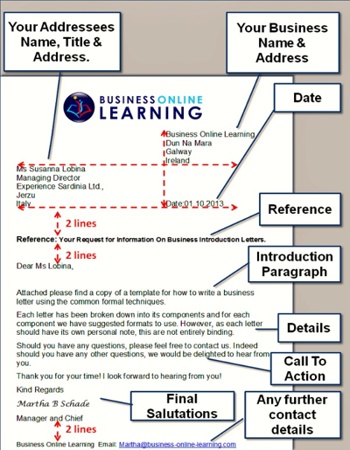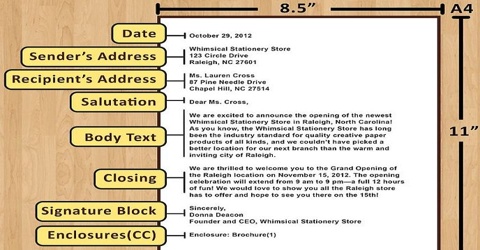Structure of a Good Business Letter
Regardless of then purposes, most business letters have some basic parts. The orderly arrangement of various parts of a business letter is known as the structure of letter. The appearance of letter often reveals the character of the writer and his organization. So business letters should be arranged in a suitable manner that can draw readers’ attention. A well structured business letters can also enhance the reputation and goodwill of the company. The parts of a well-structured business letter are as follows:
Letter heading: The letterhead contains the name, address, telephone and fax numbers and nature of business of the writer. Most business organizations use printed letterhead for correspondence. This portion of letter appears at the top of the page eider in the center or right, or left hand side.
Date line: The date line indicates the place where the date of writing the letter should be inserted. Generally the date line appears at the right hand side below the letterhead.
Reference: The reference number is used for quick identification of a letter. It is normally written at the left hand side below the letterhead.
Inside receiver address: Inside address is the full address of the receiver or receiving organization. It is written at the left hand side of the letter below the reference line.

Attention line: Attention line is used to state the name of the person along with his designation and department, who can take necessary action with regards to the message of the letter.
Subject heading: Subject heading gives a brief indication of the content of the letter. It is generally placed below the attention line.
Salutation: Salutation is the sender’s greetings to the intended reader. It appears below the subject heading and is followed by a comma (,). Various words like, Sir, Dear Sir, Madam, Gentlemen and Dear Mr. XYZ etc, are used as salutation. The use of salutation depends on the relationship between the sender and the receiver.
Body: It is the main part of a letter and contains the message or information that the writer wants to convey. Generally the body is divided into different paragraphs and each individual issue is discussed in a separate paragraph.
Complimentary Close: Complimentary Close is used to finish the letter courteously and politely. Complimentary close must always agree with the salutation used and always following by a comma (,). The most customary forms of complimentary close are – Yours faithfully, Yours truly, Yours Respectfully, Sincerely yours, Obediently yours etc.
Signature, name and Designation: Below the Complimentary Close, sender gives, his signature and then write his name and designation in separate line.
Enclosures: When anything is enclosed with the letter to supplement the message inserted in the body, an enclosure notation is used below the name and designation of the sender. If more than one enclosure is attached, enclosures should be identified by numbers.
Carbon copy: When any copy of the letter is to be distributed to a third party, it is indicated by writing ‘Copy’ or ‘Copy Circulated.” The name and designation of the recipients is written beneath or beside the notation “Copy.” When copy recipient is more than one their names should be identified in alphabetical order.
Identification mark: Identification mark is generally put in the left margin below the carbon copy to identify the person who has typed, written or composed the letter.
The appropriate arrangement of the above parts of a business letter will make a good appearance of the business letter.















